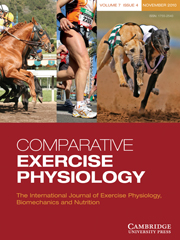Crossref Citations
This article has been cited by the following publications. This list is generated based on data provided by
Crossref.
Ferraz, Guilherme C.
Brito, Helena C.D.
Berkman, Carolina
Albernaz, Raquel M.
Araújo, Renatha A.
Silva, Matheus H.M.
D'Angelis, Flora H. de F.
and
Queiroz-Neto, Antonio
2013.
Low dose of dichloroacetate infusion reduces blood lactate after submaximal exercise in horses.
Pesquisa Veterinária Brasileira,
Vol. 33,
Issue. 1,
p.
57.
Maldonato, Aldo
2018.
IN ALTA QUOTA CON IL DIABETE TIPO 1.
il Diabete,
Vol. 30,
Issue. N. 4, dicembre 2018,
Drzazga, Zofia
Schisler, Izabela
Poprzęcki, Stanisław
Michnik, Anna
and
Czuba, Miłosz
2019.
Serum Autofluorescence and Biochemical Markers in Athlete’s Response to Strength Effort in Normobaric Hypoxia: A Preliminary Study.
BioMed Research International,
Vol. 2019,
Issue. ,
p.
1.
Lewis, V.
Douglas, J.L.
Edwards, T.
and
Dumbell, L.
2019.
A preliminary study investigating functional movement screen test scores in female collegiate age horse-riders.
Comparative Exercise Physiology,
Vol. 15,
Issue. 2,
p.
105.
McGinn, S.
Alcock, D.
and
Cameron, L.J.
2019.
A retrospective investigation of the impact of ‘eventing phase (dressage, show-jumping and cross-country)’ on pre-competition anxiety and self-confidence.
Comparative Exercise Physiology,
Vol. 15,
Issue. 4,
p.
269.
Limmer, Mirjam
de Marées, Markus
and
Platen, Petra
2020.
Alterations in acid–base balance and high-intensity exercise performance after short-term and long-term exposure to acute normobaric hypoxic conditions.
Scientific Reports,
Vol. 10,
Issue. 1,
Heck, Hermann
and
Bartmus, Ulrich
2022.
Laktat.
p.
363.
Draper, Shane
Singer, Tyler
Dulaney, Cody
and
McDaniel, John
2022.
Single Leg Cycling Offsets Reduced Muscle Oxygenation in Hypoxic Environments.
International Journal of Environmental Research and Public Health,
Vol. 19,
Issue. 15,
p.
9139.
Viscor, Ginés
Corominas, Jordi
and
Carceller, Anna
2023.
Nutrition and Hydration for High-Altitude Alpinism: A Narrative Review.
International Journal of Environmental Research and Public Health,
Vol. 20,
Issue. 4,
p.
3186.
Valentim-Coelho, Cristina
Saraiva, Joana
Osório, Hugo
Antunes, Marília
Vaz, Fátima
Neves, Sofia
Pinto, Paula
Bárbara, Cristina
and
Penque, Deborah
2025.
Red blood cell proteomic profiling in mild and severe obstructive sleep apnea patients before and after positive airway pressure treatment.
Biochimica et Biophysica Acta (BBA) - Molecular Basis of Disease,
Vol. 1871,
Issue. 5,
p.
167767.

